The 1951 Swiss Grand Prix was the first race of the 1951 Formula One Season and as there was no rule changes, most drivers and teams continued from the previous season.
Alfa Romeo brought a newly developed car, the model 159, to the Grand Prix and it would win on its debut. But the Italian marque did not enjoy the dominace that they had during the 1950 Swiss Grand Prix as Ferrari challenged. In the end the race was would once again be a inter team battle between last years champion Nino Farina and runner-up Juan Manuel Fangio who won the race with his speed and different strategy, taking an early championship lead.
The 1950 GP saw a nasty accident for French Talbot-Lago driver Eugène Martin which saw an end to his GP career, this time was his compatriot Henri Louveau who would suffer a similar fate.
Background[]
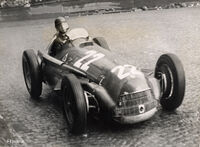
Back in Berne! Champ returns in the Alfa 159
Although the Alfa Romeo team had dominated the season, the inaugural World Championship for grand prix had been a popular success among spectators and the manufacturers alike. Giuseppe Farina had been crowned the inaugral World Drivers' Champion after a season long title battle with Alfa Romeo teammates Juan Manuel Fangio and Luigi Fagioli.
The team had released their new 159 chassis for the final race of the season at Monza, the car designed by former Ferrari man Gioacchinno Colombo and would serve as Alfa Romeo's title defence in 1951. Ferrari had however released their new Ferrari 375, the car looking incredibly competitive. Ferrari had developed the first serious threat to the Alfa Romeo superiority in years.
Dottore Giuseppe Farina remained at the Alfa Romeo in his attempts to retain the World Drivers' Championship in 1951. Alongside him, however was his chief rival, Juan Manuel Fangio who had lost the title to poor reliability on his car in 1950. Luigi Fagioli, the third title contender of 1950 would notably no longer participate at Alfa Romeo as a lead driver. Whilst he had been consistent, now aged 53, Fagioli, was no longer considered quick enough to be a lead driver. Fagioli, whilst now in semi-retirement would still commit to some races in 1951. Replacing his position as the team's third driver, was their long-time test driver, Consalvo Sanesi. Since 1946, Sanesi had operated as the team's test driver, denying the opportunity to join the race team. After making a rare racing appearance at the finale of the 1950 season at Monza, Sanesi agreed to commit to a full season in 1951. Emmanuel de Graffenried, the Swiss Baron would also be invited to drive a fourth car for his home event at the season opener at Bremgarten, Switzerland.
Enzo Ferrari's squad, Scuderia Ferrari, had a serious chance of taking the world title for 1951. The 375 had proven extremely competitive. Since the end of the world championship at Monza, Alfa Romeo have kept quiet in development. Ferrari meanwhile had been dominating the non-championship races in Alfa Romeo's absence. Their lead driver, Alberto Ascari had been fighting was clearly making progress, however a burnt arm following a Formula Two accident in Genoa would dint his chances for the race. Alongside Ascari in the team was Luigi Villoresi, Ferrari's experienced hand and mentor to the young Ascari. Ferrari were also further bolstered in 1951 with the arrival of the former Alfa Romeo test driver, Piero Taruffi who agreed to defect to Ferrari with the promise of being guaranteed a race driver. Peter Whitehead would also continue to compete in his privately owned Ferrari 125. However the old 125 was quickly becoming out of date and would not be capable of competing with the Alfa Romeo 159 or the Ferrari 375. Rudolf Fischer, the local Swiss driver and his Ecurie Espadon entry had returned for the Swiss Grand Prix in 1951. The team had tried to enter the failed constructor, SVA, into the race the previous year but the project had failed. Fischer therefore returned in 1951, the team now entering a Ferrari 212 sportscar. Pierre Staechelin also planned to enter a Ferrari 166 sportscar but failed to arrive at the circuit.
Following a difficult 1950, the Talbot-Lago no longer had the development resources to compete with the front running Alfa Romeo's and Ferrari's. Therefore the team decided to withdraw its works entry after being humiliated in performance at their home race at Reims-Gueux. However Talbot-Lago would continue to be represented on the grid by a list of predominantly French privateers. The Talbot-Lago T26C still being considered to be a solid works car.
Louis Rosier was now running Talbot-Lago's under his own team, Ecurie Rosier, where he lent his second car to Henri Louveau to compete alongside his own entrant. The talented, Jose Froilan González, had been reduced to privateer entry when his team, Scuderia Achille Varzi, withdrew from Formula One at the end of 1950. The young Argentine charger alongside Philippe Étancelin, Yves Giraud-Cabantous, Johnny Claes and Guy Mairesse as Talbot-Lago privateers.
Like Talbot-lago, the Maserati manufacturer had been totally dominated by the might of Alfa Romeo and Ferrari during 1950. At the end of 1950, they too withdrew their works entry for the 1951 season. As with Talbot-Lago, the manufacturer would only be represented by private entrants. However unlike the Talbot Lago T26C, the Maserati 4CLT/48 was in little demand, the manufacturer represented only by the two cars of the Enrico Platé team. Enrico Platé fielding a new line-up for 1951, Emmanuel de Graffenried whilst remaining in the team would balance duties as a member of the Alfa Romeo squad,and would instead represent the Italian giants for his home event. De Graffenried would therefore be replaced by Harry Schell, the rich American playboy who had found his way into the European racing scene. Prince Bira had also left the team and he was therefore replaced by Louis Chiron. Chiron, the most experienced driver on the grid having been in grand prix since 1926 had joined Enrico Platé following the withdrawal of the works Maserati team. Antonio Branca, the mysterious Swiss privateer, planned to enter his aged old 4CL, however he decided against his decision to enter the race.
The members of what was formerly the Maserati works team, found employment at rival Italian manufacturer, OSCA. OSCA, an organisation made up of the Maserati brothers who originally conceived the Maserati manufacturer, were planning to enter their new manufacturer at the end of the season. The former works Maserati driver, Franco Rol had also found solace at OSCA working as their lead test driver. Prince Bira who had been left out of the driver market at the end of 1950 in the hope of securing a BRM drive had also been involved in the testing of the new OSCA programme. Bira had planned to enter a number of events for the manufacturer, however the car's lack of reliability prevented his entry.
Simca-Gordini, another major Formula Two team would also participate in the Formula One season. The team had proved that a Formula Two team can compete in Formula One during 1950. The team had non been quick, but Robert Manzon's consistent driving had earned them points. The team planned to enter three cars for Switzerland, two for regular drivers, Maurice Trintignant and André Simon whilst a single car for privateer Francis Rochat, however the team strangely withdrew before the event.
Following in the wake of Simca-Gordini, the British HWM Formula Two team would also take the opportunity to enter their Alta engined cars into the main Formula One event at Bremgarten. The team's co-founder and lead racer driver, George Abecassis, would partner the team's second driver, the youthful Stirling Moss. At twenty two years of age, Moss was already hoping to be Britain's next motor racing star.
The final manufacturer to enter the event was that of the West German Formula Two and Sportscar manufacturer, Veritas. Germany had been banned from competing in motorsport as their manufacturers following the end of the Second World War. In 1951, the ban was lifted and Veritas with its Swiss driver, Peter Hirt would become the first German manufacturer to take part in the Formula One world championship.
The BRM project ran by Raymond Mays and Peter Berthon was believed to be Britain's next great team to challenge the Italian dominance of Alfa Romeo and Ferrari. However in non-championship runnings, the BRM proved well off the pace of the Ferrari's. At the end of 1950, Britain's lead driver, Reg Parnell had signed alongside Frenchman Raymond Sommer. However sadly, Sommer had been killed in a minor Formula Two race in France at the end of 1950. Parnell remain in the team whilst Prince Bira of Thailand replaced the unfortunate Sommer in the team. The BRM had proved problematic and due to its lack of reliability, remained off the pace of the Alfa Romeo's and Ferrari's. BRM therefore withdrew its championship entry until it was satisfied that its car could compete at the front.
Entry List[]
Qualifying[]
Report[]
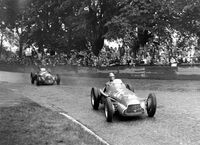
Fangio and Farina head Qualifying
The Bremgarten circuit was renown for its mist and fog that would hamper the visibility of driver's completing the circuit. However the weather was bright and sunny throughout practice, this usual threat had been removed from what was already an incredibly difficult and dangerous circuit.
It became immediately evident that Alfa Romeo remained the team to beat. Fangio took a dominant pole, nearly two seconds ahead of the reigning champion, Farina. Villoresi was the lead Ferrari in third, however he was still four seconds off Fangio's best time.
The final Alfa Romeo's of Sanesi and De Graffenried were fourth and fifth. Taruffi's Ferrari was sixth whilst Ascari still nursing burns from his accident in Genoa could only manage seventh on the grid. Rosier was the fastest Talbot-Lago in eight but he sat a remarkable seventeen seconds slower to Fangio's best qualifying time.
The private Ferrari cars of Whitehead in the old 125 and Rudolf Fischer, the second home talent running tenth in the Ferrari sportscar. Eleventh to thirteenth was rounded out by the Talbot-Lago's of Louveau, Étancelin and González.
Stirling Moss did well to get the little HWM-Alta to fourteenth on the grid. Giraud-Cabantous was fifteenth in the Talbot-Lago ahead of Peter Hirt in the Formula Two Veritas car. The leading Maserati of Harry Schell could only manage a dismal seventeenth. Claes was eighteenth in the Talbot-Lago ahead of Chiron's Maserati. The final row of the grid was occupied by Abecassis's HWM and Mairesse's Talbot-Lago.
Results[]
| Pos | No. | Driver | Constructor | Time | Gap |
|---|---|---|---|---|---|
| 1 | 24 | 2:35.9 | — | ||
| 2 | 22 | 2:37.8 | +1.9 | ||
| 3 | 18 | 2:39.3 | +3.4 | ||
| 4 | 28 | 2:40.3 | +4.4 | ||
| 5 | 26 | 2:41.8 | +5.9 | ||
| 6 | 44 | 2:45.2 | +9.3 | ||
| 7 | 20 | 2:46.0 | +10.1 | ||
| 8 | 8 | 2:52.7 | +16.8 | ||
| 9 | 16 | 2:52.9 | +17.0 | ||
| 10 | 38 | 2:54.1 | +18.2 | ||
| 11 | 10 | 2:56.2 | +20.3 | ||
| 12 | 4 | 2:57.3 | +21.4 | ||
| 13 | 42 | 2:57.3 | +21.4 | ||
| 14 | 14 | 2:58.4 | +22.5 | ||
| 15 | 6 | 3:00.3 | +24.4 | ||
| 16 | 52 | 3:01.6 | +25.7 | ||
| 17 | 32 | 3:02.4 | +26.5 | ||
| 18 | 2 | 3:02.5 | +26.6 | ||
| 19 | 30 | 3:03.1 | +27.9 | ||
| 20 | 12 | 3:03.8 | +29.2 | ||
| 21 | 40 | 3:12.0 | +36.1 |
Grid[]
| Pos | Pos | Pos | |||
|---|---|---|---|---|---|
| Driver | Driver | Driver | |||
| ______________ | |||||
| ______________ | 1 | ||||
| ______________ | 2 | Juan Manuel Fangio | |||
| 3 | Nino Farina | ||||
| Luigi Villoresi | |||||
| ______________ | |||||
| ______________ | 4 | ||||
| 5 | Consalvo Sanesi | ||||
| Toulo de Graffenried | |||||
| ______________ | |||||
| ______________ | 6 | ||||
| ______________ | 7 | Piero Tarrufi | |||
| 8 | Alberto Ascari | ||||
| Louis Rosier | |||||
| ______________ | |||||
| ______________ | 9 | ||||
| 10 | Peter Whitehead | ||||
| Rudi Fischer | |||||
| ______________ | |||||
| ______________ | 11 | ||||
| ______________ | 12 | Henri Louveau | |||
| 13 | Philippe Étancelin | ||||
| José Froilán González | |||||
| ______________ | |||||
| ______________ | 14 | ||||
| 15 | Stirling Moss | ||||
| Yves Giraud-Cabantous | |||||
| ______________ | |||||
| ______________ | 16 | ||||
| ______________ | 17 | Peter Hirt | |||
| 18 | Harry Schell | ||||
| Johnny Claes | |||||
| ______________ | |||||
| ______________ | 19 | ||||
| 20 | Louis Chiron | ||||
| George Abecassis | |||||
| ______________ | |||||
| ______________ | 21 | ||||
| ______________ | 22 | Guy Mariesse | |||
| 23 | |||||
Race[]
Report[]
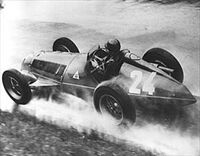
Farina streaks away in the wet
Practice had been bright and sunny, however the race day yielded only heavy rain on the treachorous Bremgarten circuit. Despite the rain, 170 000 spectators attended the Swiss Grand Prix. The downpour was so heavy that the Alfa Romeo and Ferrari mechanics fitted splashboards to the front of their drivers cars in order to help divert the water from the drivers faces. Farina had three extra fuel tanks fitted to his Alfa Romeo, a move that would hopefully enable him to go full distance without stopping. Fangio and De Graffenried hedged their bets by fitting only a single extra tank of fuel. Sanesi opted to add no extra fuel tanks to his car.
Due to the dismally wet conditions, the drivers were allowed to do a single exploratory lap to help understand the conditions before the start. Alfa Romeo, concerned that every drop of fuel would count to beat the more fuel efficient Ferrari's, all had their fuel tanks topped up after the formation lap before the start.
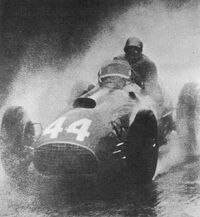
Taruffi in hot pursuit
The start of the race saw Fangio take the lead in the heavily wet conditions. Behind him came his teammates, Farina and Sanesi. Villoresi the first of the Ferrari's was applying the pressure to Sanesi in third. The Vertias-Meteor in its debut race failed to even make it off the grid. Peter Hirt's fuel feed had failed whilst waiting on the grid, he was out of his first and home grand prix.
On lap five, Villoresi had moved past Sanesi to take third place. Ascari was still struggling, his injuries from Genoa were still affecting him. Taruffi's debut race, however was going well. Ascari had waved him past when he realised he was not running competitively, three laps after that Taruffi took fifth place from the final Alfa Romeo of De Graffenried.
González's beginning as a privateer was not going well, he had been running uncompetitively in an old Talbot-Lago before his retirement on lap 10 with oil pump problems. Villoresi in third was the next driver to retire, the heavy rain was beginning to blind the Ferrari driver and on lap 13, Villoresi slid off the circuit, his Ferrari landing in a hedge. Villoresi emerged from the crash shaken but unhurt.
Ferrari had lost their highest running car, however Taruffi was beginning to put in a spirited drive. On lap fifteen he made his way past Sanesi to take third place. The Ferrari's were quick, however Fangio still dominated in the Alfa Romeo 159. He held a remarkable 40 second lead to teammate, the reigning world champion, Giuseppe Farina. Fangio with his lighter fuel than Farina was planning a single stop in comparison to Farina's non-stop strategy. On lap 22, Fangio pitted, the Alfa Romeo mechanics got him out quick enough that he exited only slightly behind Farina's car. Farina stubbornly held onto the lead for another five laps before Fangio finally retook the lead of the race.
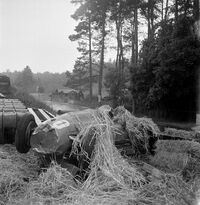
Louveau's career ended with a broken leg
The Bremgarten circuit was proving treacherous as ever, more so on the heavily wet circuit. Giraud-Cabantous' Talbot-Lago and Abecassis's HWM were both early retirements. More seriously, however on lap 30, the private Talbot-Lago of Henri Louveau skated off the circuit, Louveau's car flipped and the Frenchman was thrown out, breaking his leg in the process. It had been a very nasty accident and only six laps later, Whitehead crashed into the same place, his private Ferrari flying into the vegetation. Whitehead exited his car with many cuts and bruises, but luckily was largely unscathed.
At the front, the Ferrari of Piero Taruffi was the only car that stood in the way of Alfa Romeo occupying the first five places in the championship. Fangio continued to dominate at the front of the race, setting fastest lap after fastest lap. Farina in second had begun to suffer from handling problems and was beginning to fall back into the clutches of Taruffi's Ferrari.
The struggling Alfa Romeo of Farina had little to defend against the Ferrari of Taruffi. The world champion letting Taruffi past, Sanesi in fourth place was a whole lap adrift. Fangio went on to complete the event, dominating the field with Taruffi's Ferrari in second nearly a minute down. Taruffi proved his competitiveness with a second in the Ferrari ahead of Farina who was frustrated to be acosted with handling problems. In fourth and fifth came the other Alfa Romeo's of Sanesi and De Graffenried. The injured Ascari had trawled home a disappointing sixth place, his pre-race injuries costing him a chance for points.
Grand Prix debutant, Stirling Moss had driven a good first race in his Formula Two HWM. Moss, despite smashing his front windscreen early on in the race and running on very low fuel was looking on course to take seventh place in his first race. His car however ground to a halt in the last hundred metres of the race. Moss elected to get out and push his car to the line, however Chiron's Enrico Platé Maserati managed to pip through in the last seconds to take seventh away from Moss.
Rosier in the leading Talbot-Lago was ninth, three laps adrift of the lead. Étancelin finished tenth in his Talbot-Lago whilst Rudolf Fischer brought the Ferrari sportscar home in eleventh. Schell could only manage twelfth in his Maserati ahead of the final finishers of Claes and Mairesse's Talbot-Lago's.
Results[]
| Pos | No | Driver | Constructor | Laps | Time/Retired | Grid | Points |
|---|---|---|---|---|---|---|---|
| 1 | 24 | 42 | 2:07:53.64 | 1 | 9 | ||
| 2 | 44 | 42 | + 55.24 | 6 | 6 | ||
| 3 | 22 | 42 | + 1:19.31 | 2 | 4 | ||
| 4 | 28 | 41 | + 1 Lap | 4 | 3 | ||
| 5 | 26 | 40 | + 2 Laps | 5 | 2 | ||
| 6 | 20 | 40 | + 2 Laps | 7 | |||
| 7 | 30 | 40 | + 2 Laps | 19 | |||
| 8 | 14 | 40 | + 2 Laps | 14 | |||
| 9 | 8 | 39 | + 3 Laps | 8 | |||
| 10 | 4 | 39 | + 3 Laps | 12 | |||
| 11 | 38 | 39 | + 3 Laps | 10 | |||
| 12 | 32 | 38 | + 4 Laps | 17 | |||
| Ret | 16 | 36 | Accident | 9 | |||
| 13 | 2 | 35 | + 7 Laps | 18 | |||
| 14 | 40 | 31 | + 11 Laps | 21 | |||
| Ret | 10 | 30 | Accident | 11 | |||
| Ret | 12 | 23 | Magneto | 20 | |||
| Ret | 6 | 14 | Ignition | 15 | |||
| Ret | 18 | 12 | Accident | 3 | |||
| Ret | 42 | 10 | Oil Pump | 13 | |||
| Ret | 52 | 0 | Fuel Pump | 16 |
Milestones[]
Debut - George Abecassis & Stirling Moss
Standings after race[]
| Pos. | Driver | Pts | +/- |
|---|---|---|---|
| 1 | 9 | — | |
| 2 | 6 | — | |
| 3 | 4 | — | |
| 4 | 3 | — | |
| 5 | 2 | — |
Notes[]
| V T E | ||
|---|---|---|
| Circuits | Bremgarten (1934 - 1939, 1947 - 1954), Dijon-Prenois (1975, 1982) | |
| Races | 1950 • 1951 • 1952 • 1953 • 1954 • 1955 • 1982 | |
| Pre-war championship Races | 1935 • 1936 • 1937 • 1938 • 1939 | |
| Non-Championship Races | 1934 • 1947 • 1948 • 1949 • 1975 |
| v·d·e | Nominate this page for Featured Article |
